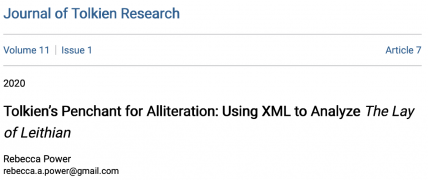
Tolkien’s penchant for alliteration: Using XML to analyze The Lay of Leithian
7 January 2021 | Journal of Tolkien Research, Volume 11, № 1, 7
This analysis of J.R.R. Tolkien’s The Lay of Leithian focuses on the inclusion of alliteration in the poem, aided by the encoding of the poem in XML and the creation of accompanying XSLT documents that transform and represent the data encoded. Tolkien’s unfinished poem The Lay of Leithian, totalling 4223 lines across 14 cantos, exists in various drafts compiled by Christopher Tolkien and published in The Lays of Beleriand. The Lay of Leithian is written in octosyllabic couplets, following the form of the lay, and is organized into stanzas and cantos of varying length that divide the narrative action. Although written in the style of a lay, a non-alliterative poetic form, The Lay of Leithian contains a considerable amount of alliteration. The data from this analysis provides a basis for further exploration into how and why Tolkien uses alliteration within the poem, and what effect it creates throughout. Because The Lay of Leithian is a 4223 line poem, encoding it allows for the charting of alliterative pattern types, and the percentage of alliterating lines throughout. By representing the data in more objective ways while looking at the poem as a whole, it becomes possible to identify overarching patterns that may not be discernable at the line or stanza level, considering the substantial length of the poem. This analysis reveals three significant findings: passages with positive descriptions often contain alliteration; narratively significant words alliterate the most; and passages with alliteration that describe Beren and Lúthien use plosive and liquid consonants respectively.
❧